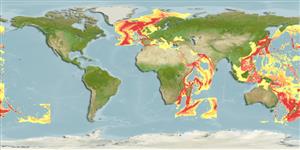Common names from other countries
Classification / Names / Names
Nomi Comuni | Sinonimi | Catalog of Fishes (gen., sp.) | ITIS | CoL | WoRMS
Environment: milieu / climate zone / depth range / distribution range
Ecologia
; salmastro; distribuzione batimetrica 0 - 3848 m (Ref. 107202). Temperate
Northeast Atlantic, the Mediterranean and Indo-West Pacific. Tropical to temperate.
Length at first maturity / Size / Peso / Age
Maturity: Lm ? range ? - ? cm Max length : 5.5 cm TL maschio/sesso non determinato; (Ref. 7882)
Species' maximum length from the Belgian part of the North Sea (Ref. 7882). Found in estuarine and inshore areas (Ref. 96352); along coastal zones in fine to medium-grained sediment with low mud content. Digs U-shaped burrows (Ref. 7882). Discretely motile tentaculate suspension and surface deposit feeder (Ref. 125928).
Life cycle and mating behavior
Maturità | Riproduzione | Deposizione | Uova | Fecundity | Larve
Members of the class Polychaeta are mostly gonochoric (sexual). Mating: Females produce a pheromone attracting and signalling the males to shed sperm which in turn stimulates females to shed eggs, this behavior is known as swarming. Gametes are spawned through the metanephridia or body wall rupturing (termed as "epitoky", wherein a pelagic, reproductive individual, "epitoke", is formed from a benthic, nonreproductive individual, "atoke"). After fertilization, most eggs become planktonic; although some are retained in the worm tubes or burrowed in jelly masses attached to the tubes (egg brooders). Life Cycle: Eggs develop into trocophore larva, which later metamorph into juvenile stage (body lengthened), and later develop into adults.
Harms, J. 1993. (Ref. 2711)
IUCN Red List Status (Ref. 130435)
CITES status (Ref. 108899)
Not Evaluated
Not Evaluated
Human uses
| FishSource |
Strumenti
Informazioni ulteriori
Age/SizeAccrescimentoLength-weightLength-lengthMorfologiaLarveAbbondanza
Fonti Internet
Estimates based on models
Preferred temperature
(Ref.
115969): 0.2 - 8.9, mean 4 (based on 437 cells).
Price category
Unknown.
